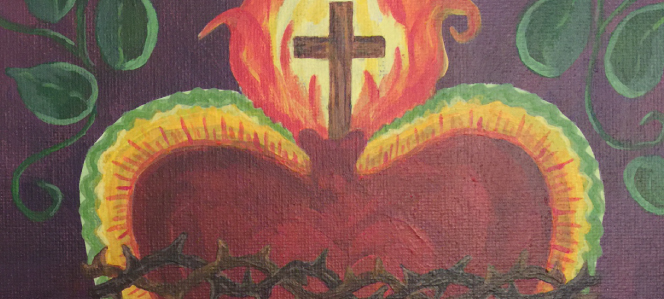It may sound weirdly whimsical, but there came a day in my life when I realized that the very heart of Jesus Christ had been pursuing me—following me around, or showing up wherever I happened to be going, in the way a smitten ninth grader finds opportunities to be around his crush.
He was leaving me mash notes, in a manner of speaking, and they all were some variation of the same theme: his heart was on fire for me; his suffering was for me; the dreadful thorns in his crown—all of it had been rendered an as offering, for me. And now he was wooing me, by inviting me to share in them through trust, and fearlessness.
It seemed wherever I turned, I was encountering a depiction of the Sacred Heart of Jesus. If I walked at a nearby lake, I found an image of the Sacred Heart, pinned to a tree. If I clicked to the pages of the artist Daniel Mitsui, I found the Sacred Heart, triumphant in one piece, almost painfully raw in another. On the ground or in the ether, wherever I roamed it seemed the Sacred Heart was there.
One day I stumbled upon an image of the Sacred Heart—just the heart, alone—that was crudely drawn, and yet deeply alive, with jagged colors surrounding the heart, and pulsing out from it. It struck me as the sort of artwork one might find in the Louisiana bayou—bright and coarse, possessing nothing in the way of nuance, yet powerfully evocative.
I couldn’t get it out of my mind. The stark image haunted me until finally I asked my friend Margaret, a hermit who had recently begun painting, if she couldn’t try to re-create it for me. “Don’t make it pretty,” I said, “It needs to look rough and amateurish and a little daring.”
Although I had imperfectly described what I had seen, Margaret’s spin on it was just right. You see it above in the deep and bright colors, the finely-wrought thorns surrounding a pulsing heart, the flames crude and aggressive, but unable to consume either the cross or the love in which it is grounded—the green leaves that remain fresh and unwithered in its presence.
I immediately fell in love with it, and have kept it near my workspace for years. In this month of June—the month of the Sacred Heart—it is especially prominent.
Orthodox Christians say that once you acquire one Holy Icon, others will unstoppably come your way. After Margaret delivered her image, something similar began with the Sacred Heart, until it seemed like I was collecting image after image—one more unusual than the next. It wasn’t by my own design. It still seemed to me that I was being pursued, that Jesus wanted me to really focus on what he was showing me, and so I finally obeyed, and began to study not just the artwork before me, but the devotion itself.
Devotion to the Sacred Heart was one of those things both familiar and foreign to those of us whose childhood faith developed precisely during the time in which a chasm was growing between the Church’s “old ways” and the innovations of Second Vatican Council: I’d seen the Sacred Heart of Jesus everywhere, but had no strong sense of what it was all about. I’d seen the inflamed heart, bound by thorns and topped by the cross, but had never considered what it meant for humanity. It all seemed rather quaint to me—something overly-pious Catholics used to do—and the doe-eyed, soft-focus depiction of Christ that usually went with the heart seemed so appallingly sentimental as to border on kitsch.
But as I began to pray before Margaret’s image of the Sacred Heart, and to speak to Jesus specifically through his Heart, and as I began to include the Litany to the Sacred Heart in my morning prayer, I slowly began to understand the gift I was being offered.
Separated from the soft-focus images of Christ, the boldness of the Sacred Heart came through to me in surprising ways. One evening, after an hour spent in contemplation of his Heart, I wrote in my prayer journal:
Why is everyone so afraid? Don’t we realize that fear is the foundation that supports so much of our sin? I’m stupid, and sometimes I will not be afraid when perhaps I should be. But I’d rather be stupid, naive and bumbling, than so afraid, all the time.
Everyday, I ponder the Sacred Heart of Jesus before me, “abode of Justice and Love…enriching all who invoke thee…” and I realize that every concern can be placed into that huge heart, and left there, in complete trust.
Nothing is safe or pure. Everyone will have a turn (or several) in the crucible. But the Sacred Heart is a self-immolation, never consumed. It is there, in the crucible with us. What is there, then, to fear?
Christ’s heart beats with ours. In the Litany of the Sacred Heart we discover prayer with a pulse, one that aligns our rhythms to his.
Now, when life is difficult, when things seem insurmountable, when anxiety threatens, I immediately thrust all of my concerns deeply into the keeping of the Sacred Heart of Jesus, and I know then, that we are together, cross-and-crucible, and that what lies before me will be worked toward God’s own good purposes. Over and over I have found that doing this (whether for my own concerns or the needs of others) enables prayer made all the more efficacious because of my demonstrated willingness to trust in the love of Christ—a willingness which I must believe is pleasing to him since he himself told us, “Fear is useless, what is needed is trust.” (Mark 5:36 NAB, 1970)
We cannot put our concerns and our needs into any better keeping than Christ’s own ever-living, always-faithful heart.
